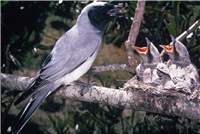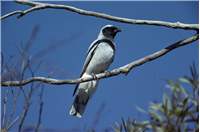Family
Campephagidae
Genus
Coracina
Species
novaehollandiae
Threats/Control Methods - Regional
This species may cause a threat to Canberra's surrounding woodlands by spreading weed seeds through eating introduced berries and seeds. Feral Cats (Felis catus) wandering in the surrounding woodland areas pose a threat to young birds in the nest.
Threats/Control Methods - Local
The continued loss of areas with thick tree stands may threaten this species in future.
Local/Urban Actions
Residents with gardens free of any weed species are helping maintain healthy habitats for native birds. Domestic pets are less of a threat if kept on a lead or offered a stimulating indoor environment or enclosure.
Common Names
Black-faced Cuckoo-shrike, Blue Jay, Shufflewing
Distinguishing Features
This fairly large bird of 30-36 cm has a unique shape due to its up-shuffled wing. It has a distinctive black face, throat, beak and eye, with black feather tips on the wing. Their back, wings and tail are blue-grey, while their underparts are white. Juvenile birds have much less black colouring and are a more faded grey colour.
Survey Techniques
Call and visual identification.
Species Call
A loud, harsh, yet musical decent of 'churrieer'.
Similar Species
The White-bellied Cuckoo-shrike (Coracina papuensis) is slightly smaller with similar coloured body and wings, but has a much smaller eye patch of black. It is not common in the ACT.
Distribution
This species is found right across Australia, including TAS.
Country of Origin
Australia
Conservation (Pet/Pest) Status - Regional
Numbers in the Canberra region drop slightly over winter as the bird migrates a small distance. Overall, the population is fairly stable with a slight decline.
Conservation (Pet/Pest) Status - National
Secure, not listed under the EPBC Act 1999.
LSCCES Population
Some birds were found at BMP and NMA and a few at ANU, BMt, ANBG and CSIRO.
Associated vegetation community
As this species is found across the entire continent, it survives in most environments with trees, including thick woodland, forests and suburban backyards.
Limiting Resources
This species inhabits areas with thick tree stands and with a shrub or ground layer of vegetation. Areas free from predation by Cats (Felis catus) are more favourable for successful breeding.
Breeding
In the Canberra region, most nesting activities occur from mid-November to early January. Nests can be constructed at a range of heights, on an exposed tree branch. Their nests seem extremely small for the size of the bird, made up of sticks and bark bound with a spider web. Two creamy-brown eggs with brown spots are laid. The young are dependant for about 21 days and they can be seen from December to mid-April. Both parents share responsibilities.
Behaviour
The Black-faced Cuckoo-shrike is known to choose the same mating partner every year and may use the same territory. They restlessly lift their folded wings upon landing on high, exposed perches of dead tree braches or powerlines. These are vantage points before swooping down to take insects and other prey.
Functional Group
Food Species
The Black-faced Cuckoo-shrike eats insects and other invertebrates by foraging on the ground, on leaves and trunks or by catching them in the air. Some fruits or seeds can also be eaten.
Predators
European Red Foxes (Vulpes vulpes), Dogs (Canis familiaris) and Cats (Felis catus) may attack this bird white foraging on the ground, however its larger size makes it stronger and less prone to predation than smaller birds.
Interesting Fact
The name Black-faced Cuckoo Strike comes from the fact that the pattern on their feathers are similar those of cuckoos and their bill shape is the same as a shrike's.
References - (reader suitability of references, P=Primary teachers, S=Secondary students, T=Tertiary students and researchers)
Books:Morcombe, M. 2000. Field Guide to Australian Birds. Steve Parish Publishing. Archerfield. Australia P, S, T
Veerman, P. 2003. Canberra Birds: A report on the first 21 years of the garden bird survey. Philip Veerman and Canberra Ornithologists Group. Canberra. S, T
Internet: Birds in Backyards 2006. [online]. Available at:http://www.birdsinbackyards.net P, S, T
Canberra Ornithological Group (COG). 2004. Birds of Canberra Gardens. COG and the ACT Department of Urban Services. [online]. Available at:http://garden.canberrabirds.org.au/ P, S, T
Online Publications: Nix, H. and Cunningham, R. 2006. Birds of the Lower Sullivans Creek Catchment, Canberra ACT. Prepared for the Life in the Suburbs project using data from the Lower Sullivans Creek Catchment Ecological Survey (LSCCES). Australian National University. Canberra. [online]. Available at: http://www.lifeinthesuburbs.com.au/category.php?id=65 S, T



 Top
Top Top
Top